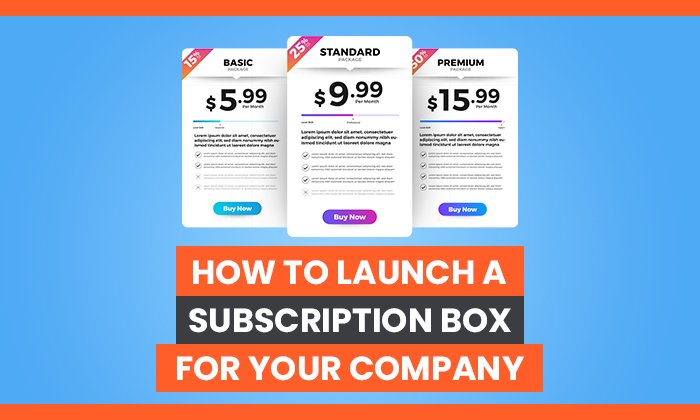HelloFresh, Fabletics, Dollar Shave Club. What do these wildly different companies all have in common?
They offer some of the best-known subscription boxes around, reflecting an increasingly popular (and potentially lucrative) business model.
The premise is simple. For a monthly fee, consumers receive a box filled with goodies ranging from sample-size toiletries to leisurewear. If you do it right, you could benefit from a loyal customer base, regular billing, predictable financials, and enhanced brand profile.
Why Should You Launch a Subscription Box?
According to MarketsandMarkets, the subscription and recurring billing market will grow to around $7.8 billion by 2025. But that’s not the only reason it could be worth giving subscription boxes a try.
Recurring Business Revenue
Subscription boxes mean you’re likely to build a consistent consumer base. According to Paysafe, 69 percent of Americans have multiple subscriptions, and 36 percent of those consumers believe they’ll invest in more soon.
This statistic is great news for companies looking to grow a stable and reliable membership base.
Plus, since your customers pay the same price each month, a subscription box offers some degree of stability in your revenue stream, which helps you predict your finances more accurately.
Improved Demand Forecasting
By offering a subscription-based service, it’s much easier to manage your stock levels. You can analyze the buying patterns of your subscriber base and predict consumer demand more accurately.
The result should be improved inventory management. You can devote more resources to buying (and selling) the products your customers truly want, and you’ll waste less stock in the process.
What’s more, you can reduce your operational costs by streamlining order fulfillment and logistical processes.
Enhanced Customer Experience
Everyone loves novelty. Whether it’s eagerly awaiting your next subscription box to exploring the contents, we all experience a rush of emotions and a surge in mood-boosting hormones like dopamine when we try new things.
Subscription boxes, then, offer much-desired entertainment value, as well as (hopefully) value for money.
How to Create a Subscription Box
Ready to create your subscription box? Here are nine steps you need to follow.
1. Research the Competition
Your first step is researching the competition for the type of box you want to create:
- Identify your specific niche. The narrower the niche and the more “specialized” your subscription box, the better things may be.
- Check out the top-performing boxes in your niche. Assess what works and what they could improve on.
- Aim to offer something your competitors don’t.
Here’s an example. Say you’re in the beauty niche. There are already a few successful beauty boxes on the market, such as Glossybox:

Glossybox carries a wide variety of skincare products from big companies all around the world. If you want to be in this niche, perhaps consider narrowing it down by choosing only to use small businesses or those from a specific region of the United States.
2. Develop a Business Plan
What’s included in a business plan varies depending on your business, but here are the key areas you should cover:
Summary
This should be a brief overview of your box, explaining who your target market is, who your competitors are, and how you’ll run your business.
Target Market
Identify a problem your box can solve. Next, determine your target consumer, meaning the person who needs that problem solved. You can use both demographic and psychometric profiling for this.
Business Model
Decide which business model you’re using for your box. There are three main types: curation, replenishment, and access.
Curation-type boxes offer samples of new products or items selected based on a consumer’s personal preferences. Glossybox, which we talked about earlier, is this type of box.
Replenishment boxes offer regular deliveries of essential items, such as diapers or groceries. The popular Dollar Shave Club uses this model, allowing customers to build packages of grooming essentials that are then sent to them regularly.
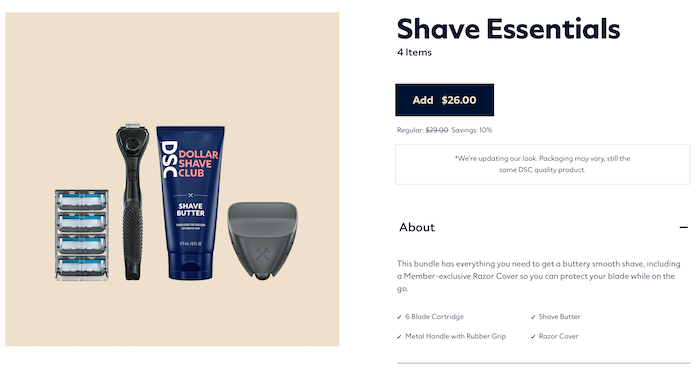
With an access model, your subscribers receive “exclusive” perks and members-only prices.
NatureBox blends replenishment with an access-based model. It’s free to use the service, but if you sign up for a paid membership, you get a special discount on your boxes:
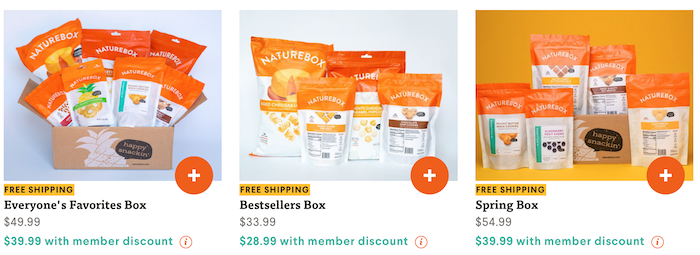
The model you choose depends on what you’re selling and your long-term business goals.
Marketing Plan
Your marketing plan should include your marketing budget, overall marketing strategy, and plan for tracking metrics.
Costs
There are a few costs to consider, including packaging costs and monthly outlays like software and accounting fees.
Metrics
You should track, at minimum, the following four metrics:
- Churn rate (CR): CR is how many customers you lose, on average, each month.
- Average revenue per user (ARPU): ARPU is how much money you earn per user.
- Lifetime value (LTV): LTV is how much you earn from the average customer over their membership’s lifetime. It could be a few months before you can work this out.
- Customer acquisition cost (CAC): This refers to how much it costs to acquire a new customer.
Distribution, Sourcing, and Fulfilment
Set out where you’ll get your products, the type of packaging you’ll use, and how you’ll distribute the subscription box.
Pricing
Simply put, include your box price (or price levels) in your business plan.
Company Overview
In this section, set out your mission statement and company values.
Key Personnel
Identify your key team members, the roles they play, and why they’re right for the jobs.
3. Determine Which Products to Include In the Box
Choosing the right items is hard. Most companies overcome this by offering a certain type of box, such as the ones below.
Themed Subscription Boxes
A themed subscription box is centered around a theme that appeals to your target audience. From the holidays to a much-loved film franchise, there’s no limit to the themes you can choose from.
Here’s an example from OwlCrate, a popular book subscription box. Though the overarching theme is “books,” they further narrow it down every month. For example, in February 2021, their theme was “magic.” The box contained a book with a magical story and merch related to other books about magic.
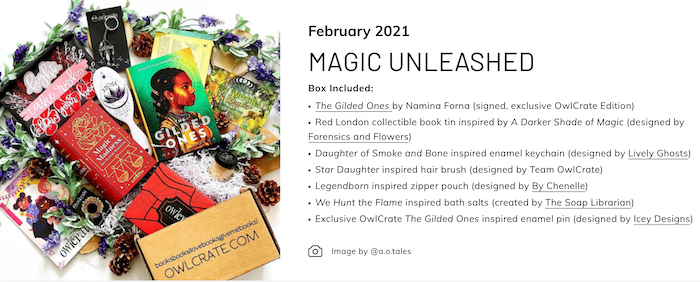
Personalized Subscription Boxes
With a personalized subscription box, you handpick items to include based on someone’s shopping behaviors and personal taste. Companies using this model ask buyers for feedback to personalize the boxes each month.
According to research by McKinsey, 28 percent of box subscribers want a personalized box, so this is not a bad way to go if it fits with your brand’s plan and resources.
Bestseller Subscription Boxes
Introduce new customers to your brand by launching a subscription box packed with your top-selling products.
For instance, if your brand sells beauty products and your rose oil face serum is flying off the shelves, you could include it in your box. While it may seem strange to include your bestsellers in a box, they could entice new buyers, and, when relevant, you could do it in sample sizes.
Sample Subscription Boxes
Speaking of samples, you can introduce subscribers to new brands they’ve maybe never tried before. You can also network with other brands by helping them reach new audiences, which is great for building long-term relationships with other companies.
4. Set a Price or Price Levels
With so much competition out there, your box must provide great value for buyers’ money. Otherwise, you could lose subscribers pretty quickly.
How do you determine what “great value” means? Here are some tips.
Identify Your Costs
Be clear on what you’re spending per box.
- From box materials to labeling, every cost must be attributed. This includes startup costs like website fees, too.
- Time is money. Unless you plan on working for free, don’t forget to include time spent on selecting products, responding to customers, and so on.
Save money wherever possible. Maybe you could change the box packaging or get a better deal on web hosting.
Research Your Competitors
Look at popular boxes in your niche. How much do customers pay for these subscription boxes? Chances are, this is the price the average consumer in your target market feels comfortable paying for a box, so try to stay within range. (And if you want to draw people in, perhaps consider a discount on the first month.)
Consider Your Profit Margin
Set too low a margin, and your business may be unsustainable. Go too high, and you could price your box out of the market.
5. Build a Prototype Subscription Box
A prototype box shows potential customers what they could get if they purchase a subscription from you.
Note, a prototype doesn’t need to have the exact items you plan to send. It simply needs to give your viewers an idea of the number of items and the types of products to expect.
Here are the areas to cover when you’re building your prototype.
Packaging
Ideally, have an eye-catching box, so your buyers get that rush of excitement the moment it shows up on their doorsteps. This also helps anyone who see the box during transit get exposed to your box’s branding and information as well (such as a website to subscribe). However, if you’re just starting out, the world won’t end if you use regular cardboard boxes.
Packaging also includes the inner packaging—that is, how you’ll keep your products safe in transit. Don’t scrimp on this and hope for the best, or you could end up with lots of complaints, returns, or canceled subscriptions.
Products
Ensure the samples in your prototype box accurately reflect the kind of products you’ll include in a “real” box. For instance, if you have brand name products in the prototype you show customers and send them off-brand products, they may not leave great reviews or continue their subscriptions.
Photographs
Show your box in the best light by taking flattering photographs. Look to other subscription boxes in your niche for inspiration.
Here’s an example of a prototype and finished box compiled by STEM Reads Book Club and Cratejoy:
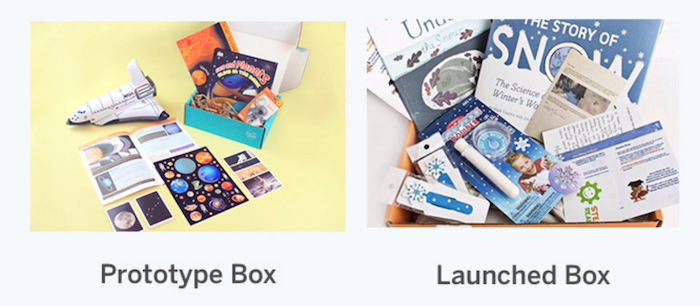
6. Determine a Shipping Process
You can either handle the shipping in-house or outsource your shipping to a partner. Which is best? That depends on your business’ resources and needs.
Handle Your Own Shipping
In-house shipping gives you complete control over the whole process, and you can quickly make adjustments based on feedback. However, in-house shipping can be more expensive than outsourcing, and the responsibility falls entirely on you if things go wrong.
If you plan on keeping subscription numbers low, it might be convenient to handle your own shipping.
Partner With a Fulfillment Service
Outsourcing can work out cheaper because you’re not paying for extras like storage, delivery fleets, and warehouse teams. It’s also easier to scale your shipping requirements to suit growing demand.
However, a bad fulfillment partner can damage your company’s reputation if orders aren’t shipped on time, and communications can break down from time to time.
Still, if you want to scale your business, outsourcing could be better long-term.
Either way, nearly 50 percent of shoppers abandon their carts because the shipping costs are too high. Whether you opt for in-house or external shipping, try to mitigate the costs where possible.
7. Set Up Your Website for Subscription Box Orders
You need to make sure your website can handle making sales. You can either set up your e-commerce store through a service like Shopify or sell through a platform like Amazon.
Depending on the selling method you choose, you might need to manually select a payment processor before you can start accepting orders. Popular options include PayPal and Stripe.
Before you launch, run a test transaction and troubleshoot before opening the store to the public.
8. Market Your Subscription Box
After you’ve completed the previous steps, it’s time to start marketing your subscription box. Here are some ways to reach your target audience:
- Sell the box to your family and friends to get some word-of-mouth marketing.
- Promote your subscription box on social media like Instagram.
- Send newsletters advertising the box to your email subscribers.
- Approach influencers in your niche and ask about potential partnerships.
- Run an online giveaway.
- Create a marketing video and post it on a platform like YouTube.
Of course, the possibilities are endless, and your marketing team may be able to find new and exciting ways to get your boxes flying out the door.
9. Review Post-Launch Feedback
Once you’ve been up and running for a few months, measure your performance.
- Make it easy for customers to leave reviews by setting up company profiles on various review sites.
- Offer incentives, such as a discount code for the next box, if a customer leaves a review.
- Identify trends in customer feedback and take action on them.
Conclusion
Whichever model you choose, a subscription box is a fun and effective way to grow your business. Just make sure you’re tracking your metrics regularly, and if you notice an increase in your churn rate, revisit your products and consider how to improve. If you need any help, you can always check out my consulting services.
Finally, don’t forget to ask for feedback and customer reviews. Whether it’s from organic customers or influencer marketing, reviews can help you build your brand.
Have you tried building a subscription box for your business?

